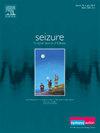治疗syn1相关癫痫发作:系统综述
IF 2.8
3区 医学
Q2 CLINICAL NEUROLOGY
引用次数: 0
摘要
突触蛋白1相关癫痫是一种罕见的疾病,患者通常表现为接触水引起的反射性癫痫发作。此外,携带突触素1基因(SYN1)致病性变异的患者可能出现发育迟缓、行为障碍和其他类型的癫痫发作。虽然syn1相关癫痫的特征越来越明显,但对于使用合适的抗癫痫药物(ASM)仍未达成共识。材料和方法:为了比较asm在这种特殊综合征中的疗效,我们使用PubMed和Embase数据库,根据PRISMA指南进行了系统的文献综述。本综述纳入了所有反映与syn1相关癫痫治疗相关的癫痫发作结局的研究,除了那些不是用英文撰写的或以海报、评论或会议摘要形式发表的研究。结果:从文献中检索到8项研究和52例有良好记录的治疗。最常用的是丙戊酸(VPA)(58%)、拉莫三嗪(LTG)(35%)和卡马西平(CBZ)(35%)。对于无癫痫发作的患者,最有效的asm是拉科沙胺(LCM)(50%)、奥卡西平(OXC)(44%)和CBZ(38%)。当考虑癫痫发作自由或显著(≥50%)癫痫发作减少时,最佳治疗是LTG(63%),其次是LCM(50%)和CBZ(50%)。与左乙拉西坦(LEV)或VPA相比,LTG、CBZ、OXC和LCM似乎与更有利的癫痫发作结果相关,携带非截断变体的患者在癫痫发作减少(p = 0.028)和癫痫发作自由(p = 0.047)方面具有统计学显著差异。结论:根据我们的系统文献综述,与VPA和LEV相比,LCM、LTG、CBZ或OXC治疗syn1相关癫痫患者可更好地降低发作频率,尽管VPA是该综合征最常用的抗癫痫药物。因此,钠通道阻滞剂似乎是这些患者的最佳治疗选择。本文章由计算机程序翻译,如有差异,请以英文原文为准。
Treating seizures in SYN1-related epilepsy: a systematic review
Introduction: Synapsin1-related epilepsy is a rare entity, in which patients typically present reflex seizures, provoked by contact with water. Moreover, patients carrying a pathogenic variant of the synapsin 1 gene (SYN1) can present developmental delay, behavior disorders, and other types of seizures. While SYN1-related epilepsy becomes better characterized, there is still no consensus on the appropriate antiseizure medication (ASM) to use.
Materials and methods: To compare ASMs efficacies in this particular syndrome, we performed a systematic literature review according to the PRISMA guidelines by using PubMed and Embase databases. All the studies reflecting the seizure outcome associated with the treatment of SYN1-related epilepsy were included in the present review, except those that were not written in English or were in the forms of poster, commentary, or conference abstract.
Results: Eight studies and a total of 52 patients with well-documented treatment were retrieved from the literature. The most frequently used ASMs were valproic acid (VPA) (58 %), lamotrigine (LTG) (35 %) and carbamazepine (CBZ) (35 %). Regarding seizure-free patients, the most effective ASMs were lacosamide (LCM) (50 %), oxcarbazepine (OXC) (44 %) and CBZ (38 %). When considering seizure-freedom or significant (≥ 50 %) seizure reduction, the best treatment is LTG (63 %), followed by LCM (50 %) and CBZ (50 %). LTG, CBZ, OXC and LCM seem to be associated with a more favorable seizure outcome compared to levetiracetam (LEV) or VPA, with a statistically significant difference in terms of seizure reduction (p = 0.028) and seizure freedom for patients carrying a non-truncating variant (p = 0.047).
Conclusion: Based on our systematic literature review, patients with SYN1-related epilepsy show better seizure frequency reduction when treated with LCM, LTG, CBZ, or OXC, compared to VPA and LEV, despite VPA being the most prescribed anti-seizure medication for this syndrome. Hence, sodium channel blockers appear to represent the best therapeutic option for these patients.
求助全文
通过发布文献求助,成功后即可免费获取论文全文。
去求助
来源期刊

Seizure-European Journal of Epilepsy
医学-临床神经学
CiteScore
5.60
自引率
6.70%
发文量
231
审稿时长
34 days
期刊介绍:
Seizure - European Journal of Epilepsy is an international journal owned by Epilepsy Action (the largest member led epilepsy organisation in the UK). It provides a forum for papers on all topics related to epilepsy and seizure disorders.
 求助内容:
求助内容: 应助结果提醒方式:
应助结果提醒方式:


